Abstract
High-rise timber structures signify a rising trend, thanks to their significant environmental and economic advantages that occur over their complete lifespan. Enhancing spatial effectiveness in these structures is a critical design consideration for project feasibility. Currently, there has been no comprehensive study on the space efficiency of such towers. This article analyzed 79 cases all over the world to deepen the knowledge of design features shaping spatial efficiency. The critical findings are as follows: (1) the most common architectural preferences include residential function, a centrally located service core, and prismatic arrangements; (2) the preferred structural material is composite, while a shear walled frame system is the favored structural system; (3) the average spatial efficiency and percentage of core area to GFA were recorded at 84% and 10%, ranging from the lowest values of 70% and 4% to the highest values of 95% and 21%, respectively; and (4) no significant differences were detected in the effect of core design approaches on spatial effectiveness if appropriately planned, with similar inferences drawn concerning form and the structural material used. This article will assist in developing design directions for different interested parties, including architectural designers taking part in the advancement of high-rise timber towers.
1. Introduction
Space efficiency in high-rise wooden buildings is a complex area of research and development, intersecting architecture, economics, technology, and sustainability [1]. As global urbanization accelerates, the need for novel and sustainable solutions in construction industry grows more urgent [2,3,4]. High-rise timber buildings, using advanced timber construction techniques, present a promising alternative to traditional steel and concrete structures [5,6,7]. This introduction examines key aspects in this emerging field, including architectural, economic, technological, sustainability, social, regulatory, and cultural perspectives.
Designing high-rise wooden buildings requires a deep understanding of timber’s properties and urban dynamics, leveraging its strength, flexibility, and aesthetic appeal to create robust, space-efficient structures [8,9,10,11,12,13,14]. While wood’s strength-to-weight ratio and engineered enhancements support complex buildings, challenges like stability, wind, seismic resistance, and durability must be addressed [15,16,17,18]. Hybrid systems combining wood with steel and concrete improve efficiency and safety [19,20,21]. Economically, initial costs may be higher, but savings can be achieved through reduced construction times and lower foundation costs, with rising demand for sustainable solutions potentially boosting financial viability [22,23,24,25,26,27]. Technological advances, including digital tools and prefabrication, optimize space efficiency, while ongoing research enhances timber’s fire resistance, acoustic insulation, and load-bearing capacity [28,29,30,31,32,33]. Sustainability is a key advantage, as timber has a lower carbon footprint and supports biodiversity, with wooden buildings being adaptable and easier to recycle [34,35,36]. Socially, timber buildings offer a warmer, more natural environment, improving occupant well-being and supporting local economies by creating jobs in sustainable forestry and manufacturing [37,38,39]. Effective implementation depends on evolving regulatory frameworks that adapt building codes to timber’s unique characteristics, with countries like Canada and Sweden leading the way [40]. Shifting cultural perceptions of wood as a viable material for high-rise buildings through education and successful examples is essential to increasing acceptance [41,42,43].
Despite extensive analyses of the technical, ecological, and financial aspects of wooden construction [44,45,46,47], there is a significant gap in research focused on spatial efficiency in wood constructions. Such research would enrich existing knowledge and provide valuable insights for stakeholders aiming to develop more effective and sustainable timber buildings.
In the field of spatial efficiency research in buildings, various studies have explored efficiency across different building types and contexts, highlighting both similarities and differences. Ilgın and Aslantamer [48], Aslantamer and Ilgın [49], and Tuure and Ilgın [50] focused on wooden structures, with efficiencies ranging from 78% to 88% in residential, office, and mid-rise timber buildings. Conversely, Ilgın [51,52,53,54,55], Ilgın and Aslantamer [56], and Aslantamer and Ilgın [57] examined skyscrapers of various uses and regions, finding efficiency ratios from 67% to 76%. Further, Ilgın and Aslantamer [58] and Ilgın [59] reported a 72% efficiency in prismatic and tapered towers, while Okbaz and Sev [60] identified conical architectural configurations as the most efficient in high-rise office buildings. In residential structures, Ibrahimy et al. [61] noted deviations due to poor planning in Kabul, while Hamid et al. [62] found that corner positioning enhances efficiency in Sudanese homes. Hotels also benefited from spatial efficiency, as studied by Suga [63]. In advanced technological contexts, Goessler and Kaluarachchi [64] showed significant efficiency improvements in high-density urban areas. On the other hand, Arslan Kılınç [65] highlighted that service core space increases with tower height. Sev and Özgen [66] focused on load-bearing and core configurations. Kim and Elnimeiri [67] emphasized optimal structural systems in multi-use buildings. Höjer and Mjörnell [68] proposed a model considering digitalization’s impact on internal use of the buildings, while Nam and Shim [69] found corner cuts minimally impacted efficiency in tall towers. Zhang et al. [70] improved solar gains in freeform designs with minimal efficiency loss. Saari et al. [71] linked higher spatial efficiency to achieving comfort goals in tall office structures, and Von Both [72] enhanced urban planning effectiveness through stakeholder assessments.
This literature review indicates a notable gap in works on spatial efficiency in high-rise wooden buildings worldwide. To address the gap, this paper analyzes 79 cases, examining critical architectural and structural parameters to identify key factors affecting space efficiency. It considers functional use, form, core planning, load-bearing systems, and materials. This study aims to provide design guidance for architects and stakeholders in high-rise timber tower projects, focusing exclusively on spatial use, intentionally excluding considerations of sustainable planning, such as energy efficiency, ecological impact, and disaster resilience, due to a lack of comprehensive data on the towers studied.
2. Methods
A case study approach was applied to gather, categorize, and scrutinize data from 79 modern high-rise timber projects around the world (Figure 1). This extensively used research technique enables detailed documentation of both qualitative and quantitative data [73,74,75]. By facilitating an in-depth exploration of architectural and structural attributes of these buildings, this approach permits researchers to thoroughly investigate real-world instances, supplying a solid framework for comprehensive inquiry. This technique provides valuable insights into the distinct design features and structural components, thus improving the comprehension of contemporary architectural implementations. By focusing on particular samples, researchers can identify similarities and variations across global designs, revealing emerging trends in modern architecture [76].
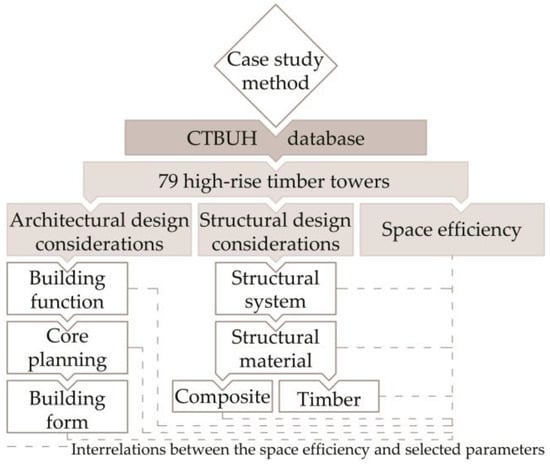
Figure 1.
Flowchart of the research method used in this study (image designed by the authors).
The definition of a ‘tall’ or ‘high-rise’ building is ambiguous, as no universal standard exists for the height or number of stories. The categorization of these terms, especially for wooden projects, remains contentious. According to the Council on Tall Buildings and Urban Habitat (CTBUH), a ‘high-rise timber building’ is defined as having eight or more floors [77]. This study used this definition. It is noteworthy that the CTBUH is a prominent public organization dedicated to promoting universal urban growth dialogue. This organization underscores the development of sustainable urban areas in the face of swift urbanization and the climate crisis. As an authority in this domain, the CTBUH decides the heights of tall structures and bestows prominent titles like “The World’s Tallest Building”. Through programs such as “Buildings of Distinction”, it recognizes outstanding projects that demonstrate exceptional design and novelty.
The inclusion of 79 towers in this article ensures a representative analysis, especially given the relative scarcity of modern high-rise wooden structures. This sample size enables the detection of key trends in spatial utilization and architectural characteristics. The variety of selected examples, encompassing different global locations, heights, and design styles, strengthens the generalizability of the results. This research scrutinizes high-rise wooden cases across a broad range of regions, including Canada, the United States, Sweden, Finland, Norway, Denmark, the Netherlands, the UK, Germany, Austria, France, Switzerland, Italy, Japan, and Australia (please see Figure 2 and Appendix A).
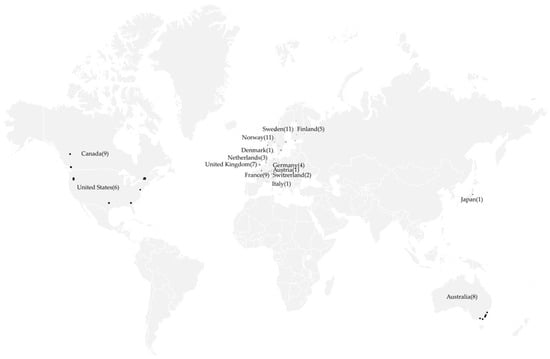
Figure 2.
High-rise timber cases depicted geographically on the world map (image designed by the authors).
Critical data required for evaluating space efficiency were acquired from official online platforms of relevant project shareholders, encompassing architects, engineers, and contractors. The researchers are engaged in a meticulous process to locate and select floor layouts, encompassing re-drawing those of low-rise and typical stories, to produce more uniform and accurate numbers for examining the spatial efficiency of 79 examples. Additionally, this detailed method of applying comparable floor plans whenever feasible seeks to yield more reliable data on spatial efficiency. Conversely, structures with inadequate information about their structural systems and architectural plans were excluded.
Architectural and structural aspects influencing space efficiency encompass the following (please see Appendix B): (a) designated function of the tower encompasses residential, office, hotel, and mixed-use configurations, integrating various combinations thereof; (b) core planning; (c) form; (d) structural system; and (e) structural material.
Regarding core types, this paper, building on the earlier literature [78,79,80], employs categorization detailed in Figure 3, which offers a more exhaustive and comprehensive approach [49]. Notable cases of skyscrapers around the globe that utilize various core configurations include Burj Khalifa (central) [81], 53 West 53 (peripheral) [82], and ADNOC Headquarters (external) [83].
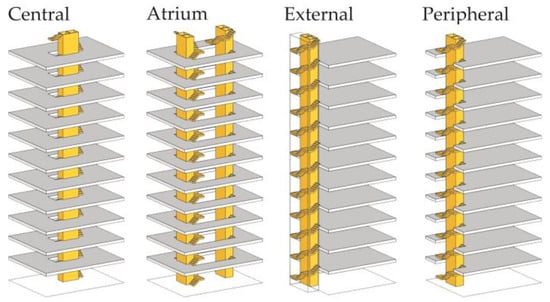
Figure 3.
Core classification (image designed by the authors).
Concerning the categorization of architectural forms, as opposed to prior studies [84,85], the method by [49] is considered more thorough for classifying tall edifices, encompassing those with free configurations. A typical tall building can be divided into three sections: apex, main tower, and base. This research principally groups forms based on main tower formation, as illustrated in Figure 4. Notable cases of skyscrapers around the globe employing various forms comprise the following: Burj Khalifa (setback) [81], 53 West 53 (tapered) [82], and ADNOC Headquarters (prismatic) [83].
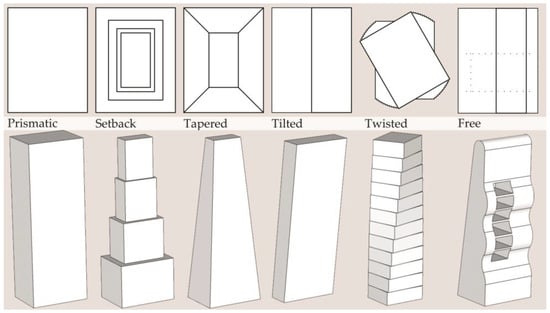
Figure 4.
Form classification (image designed by the authors).
For the lateral bracing of high-rise towers, various structural system classifications are utilized in real-life applications and widely debated in the literature [86,87,88,89,90,91,92,93]. However, the terminology for structural systems can differ across sources, even when describing the same system. This article adopts structural system categorizations by [94] due to its more detailed and comprehensive characteristics, as shown in Figure 5. Notable cases of skyscrapers around the globe using diverse structural systems are Burj Khalifa (buttressed core) [81], 53 West 53 (framed-tube) [82], and ADNOC Headquarters (shear-walled frame) [83].

Figure 5.
Structural system classification (image designed by the authors).
Structural materials are sorted in two key categories, namely, ‘timber’ or ‘entirely timber’ and ‘composite’ or ‘mixed’ materials, including amalgamations like timber with concrete or with steel, or combinations of timber, concrete, and steel, as illustrated in Figure 6.

Figure 6.
Structural material classification (image designed by the authors).
Space efficiency refers to efficient use of net floor area (NFA) in relation to GFA, a critical factor in maximizing financial returns. Achieving high spatial efficiency depends on various elements, including structural and architectural design choices, elaborated upon in Appendix C. In this paper, space efficiency was assessed by calculating two percentages: NFA to GFA and core area to GFA [48,49,50,51,52,53,54,55,56,57,58,59]. NFA, derived by subtracting service core area from GFA, represents the functional space devoted to activities, ignoring infrastructure and support services. This ratio computes how successfully floor area is utilized in real-world applications, highlighting the spatial distribution efficiency. Concurrently, the core-to-GFA ratio measures the percentage of GFA occupied by important amenities including elevators, and stairwells, providing insights into infrastructure allocation and its impact on overall space utilization efficiency.
3. Results
In this part, the essential components of architectural design that impact spatial efficiency—location, function, core configuration, and form—were analyzed. Moreover, the primary structural aspects, including systems and materials, were considered. The analysis also examined spatial efficiency and its interplay with different design elements.
3.1. Architectural Design Parameters
As seen in Figure 7a, Europe, acting as a forerunner in mass timber technology, enjoys many benefits that establish it as leading worldwide center for tall timber projects. This prominence results from various issues. First, Europe possesses well-managed forests, guaranteeing a dependable timber supply, which is crucial for mass timber building [95]. Furthermore, the region has a robust framework of strict green policies, highlighting a promise to eco-friendly construction practices [96]. These favorable conditions contribute to Europe commanding a significant 70 percent share of the global market for high-rise timber edifices.

Figure 7.
Buildings categorized by (a) location, (b) function, (c) core type, and (d) form.
This study predominantly found that 65% serve residential purposes, 29% are in office use, and 6% are characterized as mixed-use and hotel buildings, as illustrated in Figure 7b and detailed in Appendix B. On the other hand, Figure 7c shows that the central core was used most frequently, making up 58% of the cases. This choice is due to its compact design, important role in the structure, ability to allow flexible façade designs, and fire safety. These aspects make it the best option among core designs. Moreover, external and peripheral cores are less common, likely because they have drawbacks like prolonged fire escape paths. Figure 7d underlines the popularity of prismatic configurations. The simplicity of these forms makes construction easier and more efficient, reducing complexity in building processes and cutting costs. They also optimize interior space with their straightforward layouts, making room arrangements more efficient and minimizing wasted areas.
3.2. Structural Design Parameters
As presented in Figure 8a, shear walled frame systems were the most used, at over 60%, followed by shear wall systems at 28%. Shear walled frame systems combine the flexibility of frame structures with the rigidity of shear walls, providing enhanced resistance to horizontal forces [97]. This dual benefit ensures that buildings can withstand significant stress without compromising structural integrity. Additionally, shear walled frames optimize material usage, offering cost efficiency without sacrificing safety or performance. Their integration into high-rise timber construction not only improves durability but also maximizes usable space within the building, making them a practical and effective choice for architects and builders. On the other hand, Figure 8b shows the dominance of the composite approach, making up 54% of the dataset, with timber accounting for 46%. The strategic integration of timber with other materials is vital for achieving several key objectives [98,99,100,101]. These initiatives involve lowering carbon emissions, enhancing construction efficiency, and swiftly delivering critical housing to accommodate the rapidly urbanizing global population.

Figure 8.
Buildings categorized by (a) structural system and (b) material.
3.3. Space Efficiency
In this study, average spatial effectiveness and core-to-GFA ratio were 84% and 10%, respectively. These quantities spanned from the lowest values of 70% and 4% to the highest values of 95% and 21%, respectively. Table 1 demonstrates results on the space efficiency and core-to-GFA of tall timber towers [48,49] and non-timber skyscrapers [51,52,53,56].

Table 1.
Average space efficiency and ratio of core-to-GFA of different towers.
Apex Plaza, T3 Sterling Road Building 5A, 25 King, INTRO Residential Tower, and 77 Wade stand as paragons of contemporary architectural excellence, showcasing significant developments in spatial utilization, with remarkable efficiencies ranging from 93% to 95%. These projects establish a new industry standard by achieving the lowest core-to- GFA rate, as demonstrated in Appendix C. This extraordinary case is driven by thoroughly designed cores that emphasize compactness through optimization of service zones and shaft configurations, thus increasing the usable floor area. The strategic design approach minimizes the footprint of non-leasable spaces, enhancing overall building efficiency and offering flexible, expansive floor plans. Additionally, these towers incorporate shear frame systems that significantly enhance their structural rigidity against both vertical and lateral forces. This system uses compact cross-sections of load-bearing components to effectively resist loads, guaranteeing stability and safety. By integrating these advanced design principles, these buildings not only achieve superior space efficiency but also embody a commitment to sustainable urban development.
3.4. Relation of Space Efficiency and Main Design Considerations
Figure 9, Figure 10, Figure 11, Figure 12 and Figure 13 shows the existing links between architectural and structural elements related to spatial use, taking into account different functions. The bar charts on the right show the total number of structures sorted by their respective categories according to their respective functions. Colored markers show the spatial efficiency of towers relative to specific design elements. Additionally, bars represent the incidence of cases showing the same design elements within the sample.
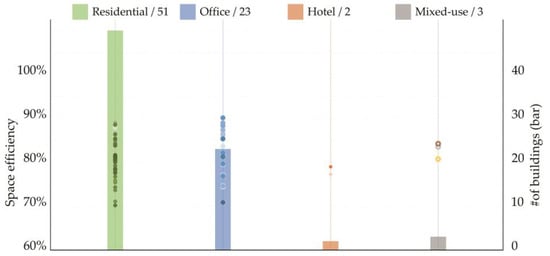
Figure 9.
Examined cases by function.
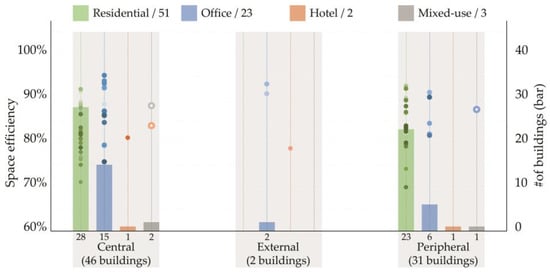
Figure 10.
Examined cases by core type.
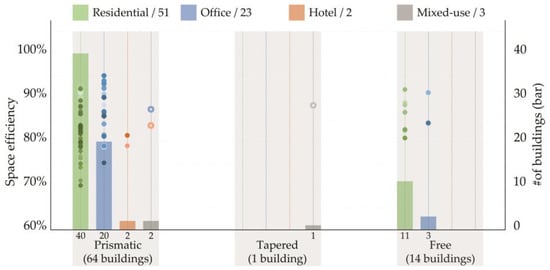
Figure 11.
Examined cases by form.
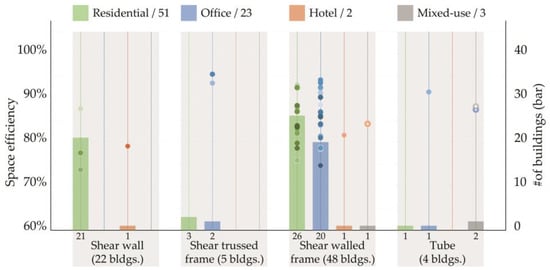
Figure 12.
Examined cases by structural system.
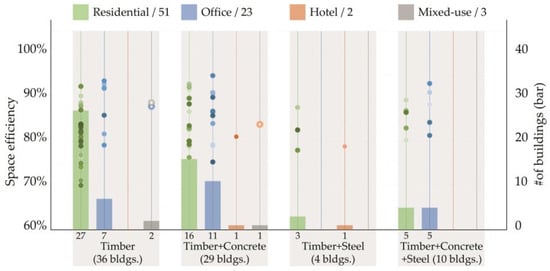
Figure 13.
Examined cases by material.
As illustrated in Figure 9, average spatial efficiencies for the 79 analyzed towers are as follows: 83% for 51 residential units and 87% for 23 office structures. The limited number of hotel and mixed-use instances prevented the calculation of an average for those categories. The efficiency metrics span from 70% to 93% for residential buildings and 75% to 95% for office projects.
As depicted in Figure 10, a central core was the principal choice, represented by 46 buildings in the dataset. These cases exhibited spatial efficiency values between 71% and 95%, with a mean efficiency of 84%. Peripheral configurations, consisting of 31 buildings, showed space efficiency percentages 70–93%, with an average efficiency of 84%. Therefore, no difference is apparent between the two core configurations.
As shown in Figure 11, a prismatic form was dominant tendency, appearing in 64 cases. These types displayed space efficiency rates between 70% and 95%, with an average of 84%. Conversely, the combined total of cases featuring free and tapered forms amounted to 15 instances.
In Figure 12, shear walled frames represent the leading structure, appearing in 48 cases. These systems exhibited spatial efficiency between 75% and 94%, with an average of 85%. Towers with a shear wall system, accounting for 22 instances, showed an average of 80%. Thus, there is a 5% difference between the two core configurations.
As seen in Figure 13, timber and composite materials are primarily employed. Timber and composite demonstrate efficiency values varying between 70% and 94% as well as 75% and 95%, with average values of 83% and 85%, respectively. Therefore, the average spatial efficiency difference between the two predominant structural materials in the dataset is merely 2%.
4. Discussion
This article focuses on assessing the spatial efficiency of high-rise timber towers globally, addressing gaps identified in previous studies. By scrutinizing data from 79 cases, the authors identified crucial aspects that influence spatial efficiency. The primary findings of this investigation are as follows: (a) residential, central core, and prismatic configurations are predominant design considerations; (b) concrete is the most favored structural material, accompanied by shear walled frames as the preferred structural system; (c) the average spatial efficiency and percentage of core area to GFA were recorded at 84% and 10% with a range from the lowest values of 70% and 4% to the highest values of 95% and 21%, respectively.
In contemporary high-rise timber edifices, a central core layout is predominantly used; this a trend is supported by extensive research [50,51,52,53] and reflective of a wider architectural and construction preference. This core design improves structural stability, increases floor area efficiency by centralizing circulation and service facilities, ensures effective vertical transportation, and facilitates architectural flexibility, which is markedly advantageous in mixed-use towers. In this paper, most buildings feature a prismatic configuration, chosen for its simplicity [51,53]. These configurations are compatible with traditional building methods, facilitating project implementation. Their regular floor plans enhance spatial use and operational efficiency, making room outlines straightforward for inhabitants.
A distinct hierarchy has developed within structural systems of wooden buildings, with high-rise timber projects predominantly utilizing shear walled frames due to their enhanced stability against lateral loads. An emerging inclination in high-rise timber construction is the growing acceptance of timber and concrete composite materials, which have become the favored choice due to their adaptability and multiple benefits [102]. This hybrid approach leverages the aesthetic warmth and appeal of timber along with the strength and versatility of concrete [103,104,105].
A recommended benchmark for assessing space efficiency of high-rise edifices is achieving 75% [106]. Research on non-timber skyscrapers discovered varying degrees of space use, typically fluctuating between 71% and 81% [51,52,53,56]. These studies highlight significant variations in the percentage of core area to GFA, varying between 16% and 26%. Furthermore, research involving 55 timber Finnish dwellings demonstrated space utilization rates spanning between 78% and 88%, with an average efficiency of 83%. Additional papers focusing on high-rise timber residential and office structures indicated space efficiencies fluctuating between 70% and 93% as well as 75% and 95%, respectively, with average efficiencies of 83% and 88%. Within this article, the average space use rate was determined to be 82%, while the core area to GFA percentage averaged 11%. Here, the lowest space efficiency was recorded at 70% and the highest at 90%, and the core area to GFA varied between 4% and 21%. These findings highlight the importance of optimizing the core design and spatial layouts to improve high-rise building efficiency. Adhering to these standards can enhance the functionality of both timber and non-timber structures, supporting more sustainable and economically viable urban environments, and advancing modern architectural practices.
The pronounced difference in space efficiency between wooden and non-wooden tall towers stems from intrinsic variances in their material properties and building practices [107,108,109]. Timber edifices exploit the advantages of lightweight frames, allowing for the use of slender structural components. This stands in stark contrast to the thicker and heavier components required in concrete or steel buildings. The integral lightness of timber facilitates the construction of thinner walls, efficiently enhancing the usable floor area within a given building footprint. Furthermore, timber’s exceptional strength-to-weight ratio supports longer spans and reduces the need for numerous internal supports, thereby increasing inner design flexibility and optimizing spatial utilization. Conversely, non-timber systems like concrete necessitate bulkier load-bearing members to achieve comparable structural capacities. This results in the construction of thicker walls and deeper floor sections, which characteristically reduce the efficiency of usable space. In addition, the heavier weight of concrete and steel demands more substantial foundations and support structures, further encroaching on the available interior space. Thus, the fundamental material and structural differences between wooden and non-wooden systems lead to significant variations in spatial efficiency, with timber offering superior optimization of interior layouts and greater overall useable floor area.
Future research on space efficiency can explore several key areas [110,111,112]. Prefabrication and modular construction techniques offer the potential for more efficient assembly and space maximization [113,114,115]. Advances in engineered timber products and nanotechnology could lead to slimmer, stronger structural profiles [116,117,118]. Architectural innovations, such as adaptable layouts and vertical green spaces, can greatly improve space efficiency and quality of life [119,120,121]. Sustainability research, including life cycle assessments and carbon sequestration strategies, is crucial for advancing timber construction’s environmental benefits [122,123,124]. Building performance studies focusing on fire safety, seismic resilience, and smart technologies can enhance safety and efficiency [125,126,127]. Economic analyses and policy advocacy are essential for promoting high-rise timber construction, supported by research on health, well-being, and cultural acceptance [128,129,130].
5. Conclusions
This study enhances the understanding of design features influencing spatial efficiency in high-rise timber structures, an increasingly relevant sector due to its environmental and economic advantages. Through the analysis of 79 global cases, key architectural and structural preferences were identified, including the predominance of residential functions, centrally located service cores, and prismatic building forms, all of which contribute to optimized spatial efficiency. The results highlight the frequent use of composite materials and shear-walled frame systems, with an average spatial efficiency of 84% and a core area percentage of 10% relative to GFA. Notably, this paper found that when appropriately planned, variations in core design, building form, and structural material do not significantly impact spatial efficiency, suggesting a level of flexibility in design choices.
Based on these findings, it is recommended that architects and engineers prioritize the use of centrally located service cores and prismatic building forms in the design of high-rise timber structures to maximize spatial efficiency. Additionally, the adoption of composite materials and shear walled frame systems is advised to further enhance the effective use of space within these buildings. This strategic focus can help optimize both the functional and feasibility of high-rise timber construction.
It is essential to recognize limitations inherent in the research. First, the sample size of 79 cases, although informative, may not fully capture the diversity and variability of high-rise timber structures globally, potentially restricting the generalizability of the results. Second, this research is cross-sectional, relying on existing buildings, which may not reflect emerging trends or future innovations in timber construction. This temporal limitation restricts the ability to assess how design preferences and spatial efficiency might evolve over time. Future research should aim to address these limitations by increasing the dataset to incorporate a wider range of cases and incorporating longitudinal studies to observe the long-term effects of design choices on spatial efficiency in high-rise timber structures.
Author Contributions
Conceptualization, H.E.I.; methodology, H.E.I. and Ö.N.A.; software, H.E.I.; formal analysis, H.E.I. and Ö.N.A.; investigation, H.E.I. and Ö.N.A.; writing—original draft preparation, H.E.I.; writing—review and editing, H.E.I. and Ö.N.A.; supervision, H.E.I. All authors have read and agreed to the published version of the manuscript.
Funding
This research received no external funding.
Data Availability Statement
The data presented in this study are available in this article.
Conflicts of Interest
The authors declare no conflicts of interest.
Appendix A. High-Rise Timber Buildings around the World
| # | Building Name | Country | City | Height (meters) | # of Stories | Completion Date |
| 1 | Metropolitan Park Building 7/8 | United States | Arlington | 99 | 23 | 2023 |
| 2 | Ascent | United States | Milwaukee | 87 | 25 | 2022 |
| 3 | Mjøstårnet | Norway | Brumunddal | 85 | 18 | 2019 |
| 4 | HoHo Wien | Austria | Vienna | 84 | 23 | 2020 |
| 5 | TRAE | Denmark | Aarhus | 82 | 20 | Under construction |
| 6 | HAUT | Netherlands | Amsterdam | 73 | 22 | 2022 |
| 7 | Sara Kulturhus | Sweden | Skellefteå | 73 | 20 | 2021 |
| 8 | De Karel Doorman | Netherlands | Rotterdam | 71 | 22 | 2012 |
| 9 | Roots Tower | Germany | Hamburg | 65 | 19 | Under construction |
| 10 | Abro | Switzerland | Risch-Rotkreuz | 60 | 15 | 2019 |
| 11 | Brock Commons Tallwood House | Canada | Vancouver | 58 | 18 | 2017 |
| 12 | Sub Station No. 164 | Australia | Sydney | 57 | 14 | 2021 |
| 13 | Hyperion | France | Bordeaux | 55 | 16 | 2021 |
| 14 | Rundeskogen Hus B | Norway | Sandnes | 55 | 16 | 2013 |
| 15 | Ngytan Koriayo | Australia | Greater Geelong | 52 | 12 | Under construction |
| 16 | 503 on Tenth | United States | Portland | 50 | 10 | 2023 |
| 17 | Treet | Norway | Bergen | 49 | 14 | 2015 |
| 18 | Lighthouse Joensuu | Finland | Joensuu | 48 | 14 | 2019 |
| 19 | 25 King | Australia | Brisbane | 47 | 10 | 2018 |
| 20 | 2150 Keith Drive | Canada | Vancouver | 45 | 10 | Under construction |
| 21 | Cederhusen | Sweden | Stockholm | 44 | 13 | Under construction |
| 22 | Hoas Tuuliniitty | Finland | Espoo | 44 | 13 | 2021 |
| 23 | Obayashi Training Facility | Japan | Yokohama | 44 | 11 | 2022 |
| 24 | Palazzo Nice Meridia | France | Nice | 44 | 10 | 2019 |
| 25 | T3 Bayside | Canada | Toronto | 42 | 10 | 2023 |
| 26 | Tallwood 1 at District 56 | Canada | Victoria | 42 | 12 | Under construction |
| 27 | Origine | Canada | Quebec | 41 | 13 | 2017 |
| 28 | Spor X | Norway | Drammen | 41 | 10 | 2021 |
| 29 | INTRO Residential Tower | United States | Cleveland | 40 | 9 | 2022 |
| 30 | T3 Sterling Road Building 5A | Canada | Toronto | 40 | 8 | Under construction |
| 31 | 77 Wade | Canada | Toronto | 38 | 8 | 2020 |
| 32 | Fyrtornet | Sweden | Malmö | 38 | 11 | Under construction |
| 33 | Rundeskogen Hus C | Norway | Sandnes | 38 | 11 | 2013 |
| 34 | Sensations | France | Strasbourg | 38 | 11 | 2019 |
| 35 | Monterey | Australia | Brisbane | 37 | 12 | 2021 |
| 36 | Aveo Bella Vista | Australia | Sydney | 36 | 11 | 2018 |
| 37 | Suurstoffi 22 | Switzerland | Risch-Rotkreuz | 36 | 10 | 2018 |
| 38 | Trafalgar Place | UK | London | 36 | 10 | 2015 |
| 39 | Apex Plaza | United States | Charlottesville | 35 | 8 | 2022 |
| 40 | Green Office ENJOY | France | Paris | 35 | 8 | 2018 |
| 41 | Opalia | France | Saint-Ouen-sur-Seine | 35 | 8 | 2017 |
| 42 | Pont de Flandres Batiment 007 | France | Paris | 35 | 8 | 2019 |
| 43 | Wood and Innovation Design Centre | Canada | Prince George | 35 | 8 | 2014 |
| 44 | Dalston Works | UK | London | 34 | 10 | 2017 |
| 45 | Hotel Jakarta | Netherlands | Amsterdam | 34 | 9 | 2018 |
| 46 | Kringsja Studentby | Norway | Oslo | 34 | 10 | 2018 |
| 47 | Rundeskogen Hus A | Norway | Sandnes | 34 | 10 | 2012 |
| 48 | SKAIO | Germany | Heilbronn | 34 | 10 | 2019 |
| 49 | The Cube Building | UK | London | 33 | 10 | 2015 |
| 50 | Forte | Australia | Melbourne | 32 | 10 | 2012 |
| 51 | Botanikern | Sweden | Uppsala | 31 | 9 | 2019 |
| 52 | Cenni di Cambiamento | Italy | Milan | 31 | 9 | 2013 |
| 53 | Kajstaden | Sweden | Vasteras | 31 | 9 | 2019 |
| 54 | Press House | UK | London | 31 | 9 | 2017 |
| 55 | Vallen | Sweden | Vaxjo | 31 | 9 | 2015 |
| 56 | Timber Pioneer | Germany | Frankfurt am Main | 30 | 8 | Under construction |
| 57 | Carbon12 | United States | Portland | 29 | 8 | 2018 |
| 58 | EDGE Suedkreuz | Germany | Berlin | 29 | 8 | 2022 |
| 59 | Stadthaus | UK | London | 29 | 9 | 2009 |
| 60 | Moholt 50/50 | Norway | Trondheim | 28 | 9 | 2016 |
| 61 | Arbora Condominium | Canada | Montreal | 27 | 8 | 2019 |
| 62 | Bridport House | UK | London | 27 | 8 | 2010 |
| 63 | DAS Kelo | Finland | Rovaniemi | 27 | 8 | 2019 |
| 64 | Docenten | Sweden | Vaxjo | 27 | 8 | 2018 |
| 65 | Dramsvegen | Norway | Tromso | 27 | 8 | 2017 |
| 66 | Frostaliden | Sweden | Skövde | 27 | 8 | 2018 |
| 67 | Highpoint Terrace | UK | London | 27 | 8 | 2017 |
| 68 | Jo & Joe | France | Gentilly | 27 | 8 | 2019 |
| 69 | LCT One | Australia | Dunrobin | 27 | 8 | 2012 |
| 70 | Limnologen | Sweden | Vaxjo | 27 | 8 | 2014 |
| 71 | Lucien Cornil Student Residence | France | Marseille | 27 | 8 | 2017 |
| 72 | Maskinparken TRE | Norway | Trondheim | 27 | 8 | 2018 |
| 73 | Pentagon I | Norway | As | 27 | 8 | 2013 |
| 74 | Puukuokka Housing Block | Finland | Jyvaskyla | 27 | 8 | 2018 |
| 75 | Residences J.Ferry | France | Saint-Dié-des Vosges | 27 | 8 | 2014 |
| 76 | Strandparken | Sweden | Stockholm | 27 | 8 | 2014 |
| 77 | The Gardens Macarthur | Australia | Sydney | 27 | 8 | 2018 |
| 78 | Trummens Strand | Sweden | Vaxjo | 27 | 8 | 2019 |
| 79 | Wood City Residential Buildings | Finland | Helsinki | 27 | 8 | 2018 |
Appendix B. High-Rise Timber Buildings by Building Form, Core Type, Structural System, and Structural Material
| # | Building Name | Form | Function | Core Type | Structural System | Structural Material |
| 1 | Metropolitan Park Building 7/8 | Prismatic | Office | Central | Shear walled frame | Composite (T+C+S) |
| 2 | Ascent | Prismatic | Residential | Central | Shear walled frame | Composite (T+C) |
| 3 | Mjøstårnet | Prismatic | Mixed-use | Peripheral | Trussed-tube | Timber |
| 4 | HoHo Wien | Prismatic | Mixed-use | Central | Shear walled frame | Composite(T+C) |
| 5 | TRAE | Prismatic | Office | Central | Shear walled frame | Composite (T+C) |
| 6 | HAUT | Free | Residential | Peripheral | Shear walled frame | Composite (T+C) |
| 7 | Sara Kulturhus | Prismatic | Hotel | Peripheral | Shear wall | Composite(T+S) |
| 8 | De Karel Doorman | Prismatic | Residential | Peripheral | Shear walled frame | Composite (T+C+S) |
| 9 | Roots Tower | Prismatic | Residential | Central | Shear walled frame | Composite (T+C) |
| 10 | Abro | Prismatic | Office | Central | Shear walled frame | Composite (T+C) |
| 11 | Brock Commons Tallwood House | Prismatic | Residential | Peripheral | Shear walled frame | Composite (T+C) |
| 12 | Sub Station No. 164 | Free | Office | Peripheral | Shear walled frame | Composite (T+C+S) |
| 13 | Hyperion | Free | Residential | Central | Shear walled frame | Composite (T+C+S) |
| 14 | Rundeskogen Hus B | Free | Residential | Central | Shear walled frame | Composite (T+C) |
| 15 | Ngytan Koriayo | Prismatic | Office | External | Shear walled frame | Composite (T+C) |
| 16 | 503 on Tenth | Prismatic | Office | Central | Shear walled frame | Timber |
| 17 | Treet | Prismatic | Residential | Peripheral | Trussed-tube | Timber |
| 18 | Lighthouse Joensuu | Prismatic | Residential | Central | Shear wall | Timber |
| 19 | 25 King | Prismatic | Office | External | Shear trussed frame | Timber |
| 20 | 2150 Keith Drive | Free | Office | Peripheral | Framed-tube | Composite (T+C) |
| 21 | Cederhusen | Prismatic | Residential | Central | Shear wall | Timber |
| 22 | Hoas Tuuliniitty | Prismatic | Residential | Peripheral | Shear wall | Timber |
| 23 | Obayashi Training Facility | Prismatic | Office | Peripheral | Shear walled frame | Timber |
| 24 | Palazzo Nice Meridia | Prismatic | Office | Peripheral | Shear walled frame | Composite (T+C) |
| 25 | T3 Bayside | Prismatic | Office | Central | Shear walled frame | Timber |
| 26 | Tallwood 1 at District 56 | Prismatic | Residential | Central | Shear trussed frame | Composite (T+S) |
| 27 | Origine | Free | Residential | Central | Shear wall | Timber |
| 28 | Spor X | Prismatic | Office | Central | Shear walled frame | Timber |
| 29 | INTRO Residential Tower | Prismatic | Residential | Peripheral | Shear walled frame | Composite (T+C) |
| 30 | T3 Sterling Road Building 5A | Prismatic | Office | Central | Shear walled frame | Timber |
| 31 | 77 Wade | Prismatic | Office | Central | Shear walled frame | Composite (T+C+S) |
| 32 | Fyrtornet | Tapered | Mixed-use | Central | Trussed-tube | Timber |
| 33 | Rundeskogen Hus C | Free | Residential | Central | Shear walled frame | Composite (T+C) |
| 34 | Sensations | Free | Residential | Central | Shear walled frame | Timber |
| 35 | Monterey | Free | Residential | Peripheral | Shear walled frame | Composite (T+C+S) |
| 36 | Aveo Bella Vista | Free | Residential | Central | Shear walled frame | Composite (T+C) |
| 37 | Suurstoffi 22 | Prismatic | Office | Central | Shear walled frame | Composite (T+C) |
| 38 | Trafalgar Place | Prismatic | Residential | Peripheral | Shear wall | Timber |
| 39 | Apex Plaza | Prismatic | Office | Central | Shear trussed frame | Composite (T+C) |
| 40 | Green Office ENJOY | Prismatic | Office | Central | Shear walled frame | Composite (T+C) |
| 41 | Opalia | Prismatic | Office | Peripheral | Shear walled frame | Composite (T+C+S) |
| 42 | Pont de Flandres Batiment 007 | Free | Office | Central | Shear walled frame | Composite (T+C+S) |
| 43 | Wood and Innovation Design Centre | Prismatic | Office | Central | Shear walled frame | Timber |
| 44 | Dalston Works | Prismatic | Residential | Central | Shear wall | Timber |
| 45 | Hotel Jakarta | Prismatic | Hotel | Central | Shear walled frame | Composite (T+C) |
| 46 | Kringsja Studentby | Prismatic | Residential | Central | Shear walled frame | Timber |
| 47 | Rundeskogen Hus A | Free | Residential | Central | Shear walled frame | Composite (T+C) |
| 48 | SKAIO | Prismatic | Residential | Central | Shear walled frame | Composite (T+C) |
| 49 | The Cube Building | Free | Residential | Central | Shear walled frame | Composite (T+C+S) |
| 50 | Forte | Prismatic | Residential | Central | Shear wall | Timber |
| 51 | Botanikern | Prismatic | Residential | Peripheral | Shear trussed frame | Timber |
| 52 | Cenni di Cambiamento | Free | Residential | Central | Shear wall | Timber |
| 53 | Kajstaden | Prismatic | Residential | Peripheral | Shear wall | Timber |
| 54 | Press House | Prismatic | Residential | Central | Shear walled frame | Timber |
| 55 | Vallen | Prismatic | Residential | Central | Shear walled frame | Composite (T+C) |
| 56 | Timber Pioneer | Prismatic | Office | Peripheral | Shear walled frame | Composite (T+C) |
| 57 | Carbon12 | Prismatic | Residential | Central | Shear trussed frame | Composite (T+S) |
| 58 | EDGE Suedkreuz | Prismatic | Office | Central | Shear walled frame | Composite (T+C) |
| 59 | Stadthaus | Prismatic | Residential | Central | Shear wall | Timber |
| 60 | Moholt 50/50 | Prismatic | Residential | Central | Shear wall | Timber |
| 61 | Arbora Condominium | Prismatic | Residential | Peripheral | Shear walled frame | Timber |
| 62 | Bridport House | Prismatic | Residential | Peripheral | Shear wall | Timber |
| 63 | DAS Kelo | Prismatic | Residential | Peripheral | Shear walled frame | Timber |
| 64 | Docenten | Prismatic | Residential | Peripheral | Shear wall | Composite (T+C) |
| 65 | Dramsvegen | Prismatic | Residential | Peripheral | Shear wall | Composite (T+C) |
| 66 | Frostaliden | Prismatic | Residential | Central | Shear walled frame | Composite (T+C) |
| 67 | Highpoint Terrace | Prismatic | Residential | Peripheral | Shear wall | Timber |
| 68 | Jo & Joe | Prismatic | Residential | Peripheral | Shear walled frame | Composite (T+C) |
| 69 | LCT One | Prismatic | Office | Central | Shear walled frame | Composite (T+C) |
| 70 | Limnologen | Prismatic | Residential | Central | Shear wall | Composite (T+C+S) |
| 71 | Lucien Cornil Student Residence | Prismatic | Residential | Peripheral | Shear walled frame | Composite (T+C) |
| 72 | Maskinparken TRE | Prismatic | Residential | Central | Shear wall | Timber |
| 73 | Pentagon I | Prismatic | Residential | Central | Shear wall | Timber |
| 74 | Puukuokka Housing Block | Prismatic | Residential | Central | Shear walled frame | Timber |
| 75 | Residences J.Ferry | Prismatic | Residential | Peripheral | Shear walled frame | Timber |
| 76 | Strandparken | Prismatic | Residential | Peripheral | Shear wall | Composite (T+S) |
| 77 | The Gardens Macarthur | Prismatic | Residential | Peripheral | Shear wall | Timber |
| 78 | Trummens Strand | Prismatic | Residential | Peripheral | Shear wall | Timber |
| 79 | Wood City Residential Buildings | Prismatic | Residential | Peripheral | Shear walled frame | Timber |
| Note on abbreviations: ‘(T+C+S)’ indicates composite/hybrid structures combining timber and concrete and steel; ‘(T+C)’ indicates composite/hybrid structures combining timber and concrete; ‘(T+S)’ indicates composite/hybrid structures combining timber and steel. | ||||||
Appendix C. Space Efficiency and Core/GFA of High-Rise Timber Buildings
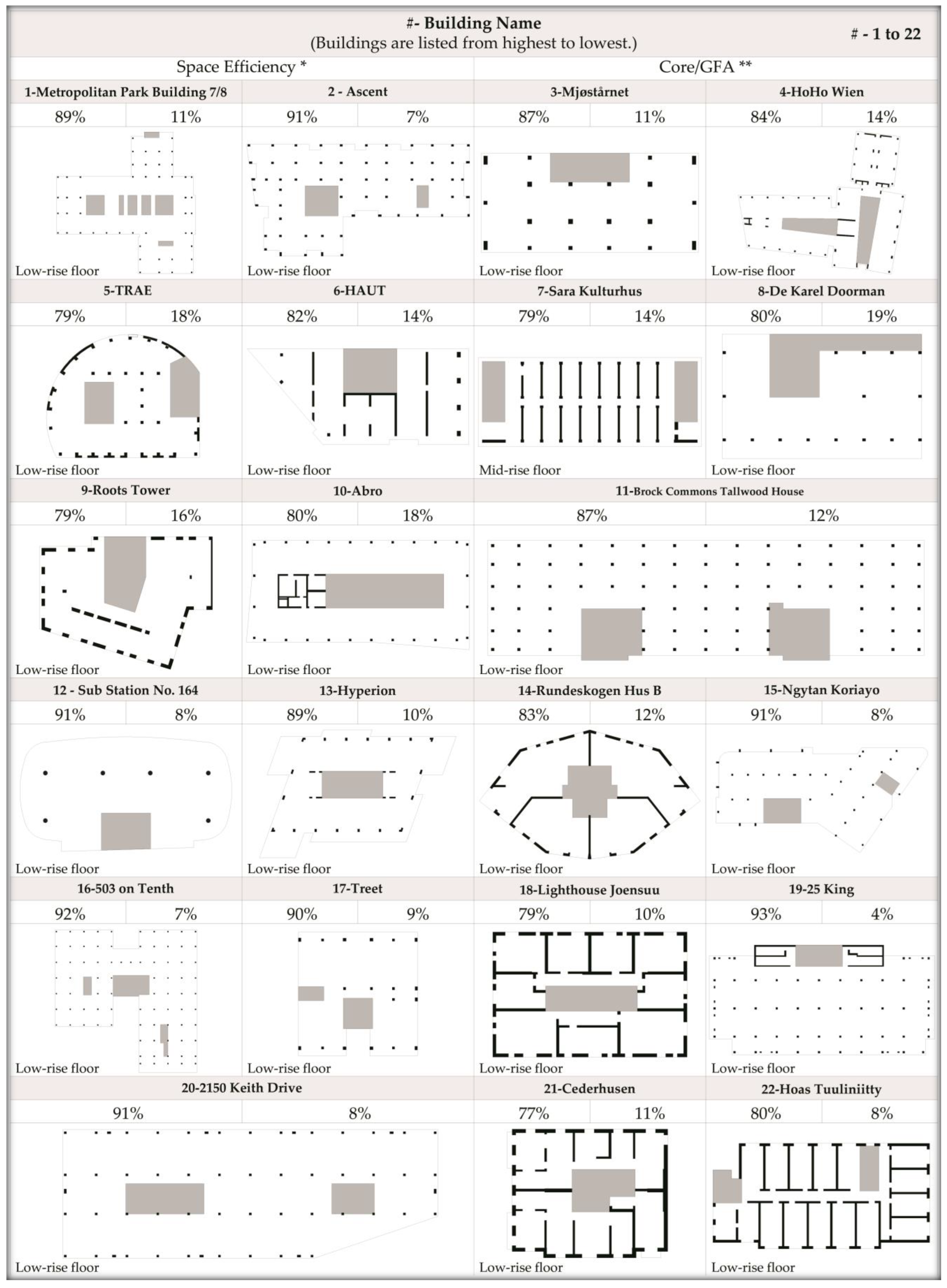
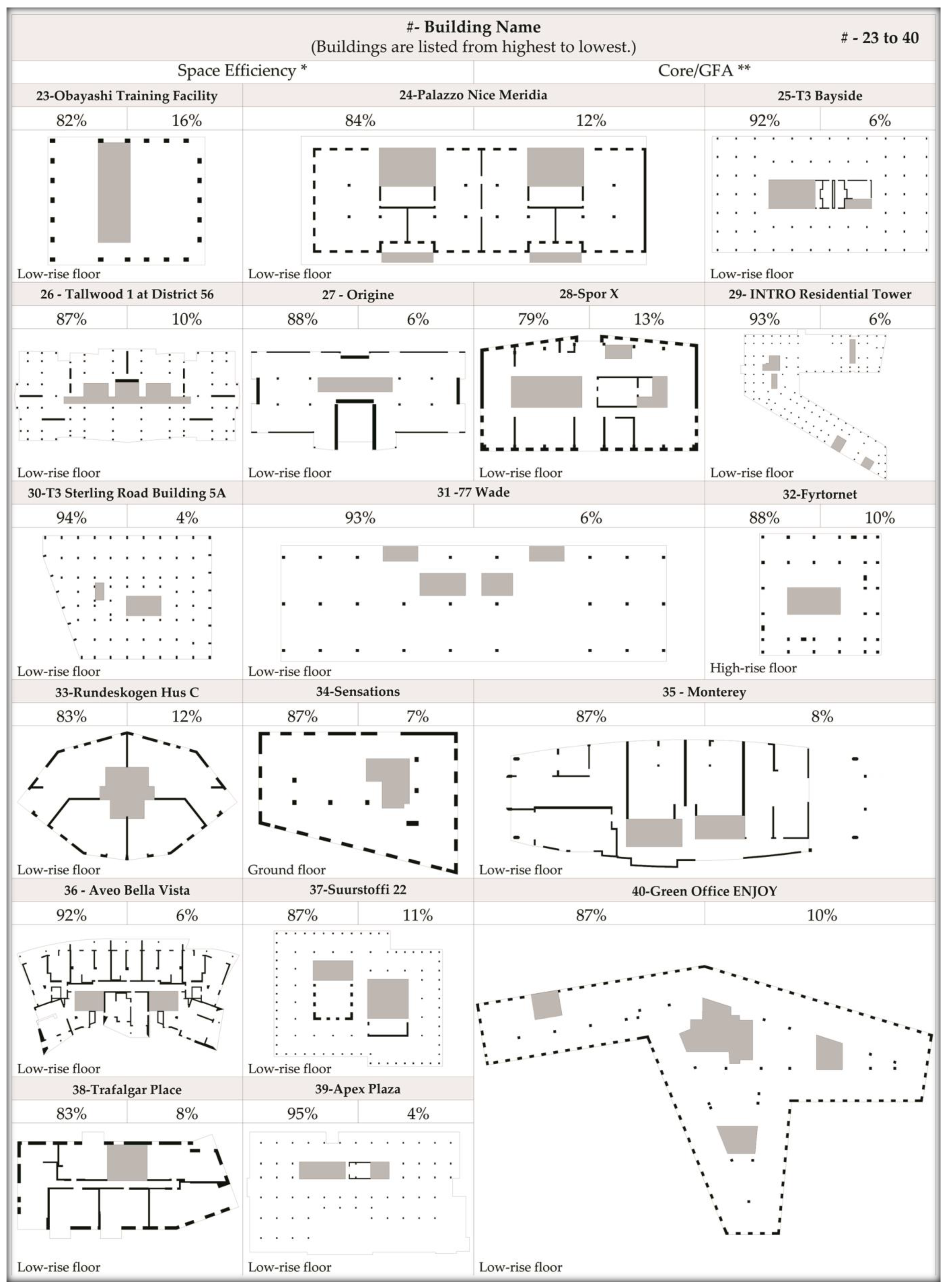
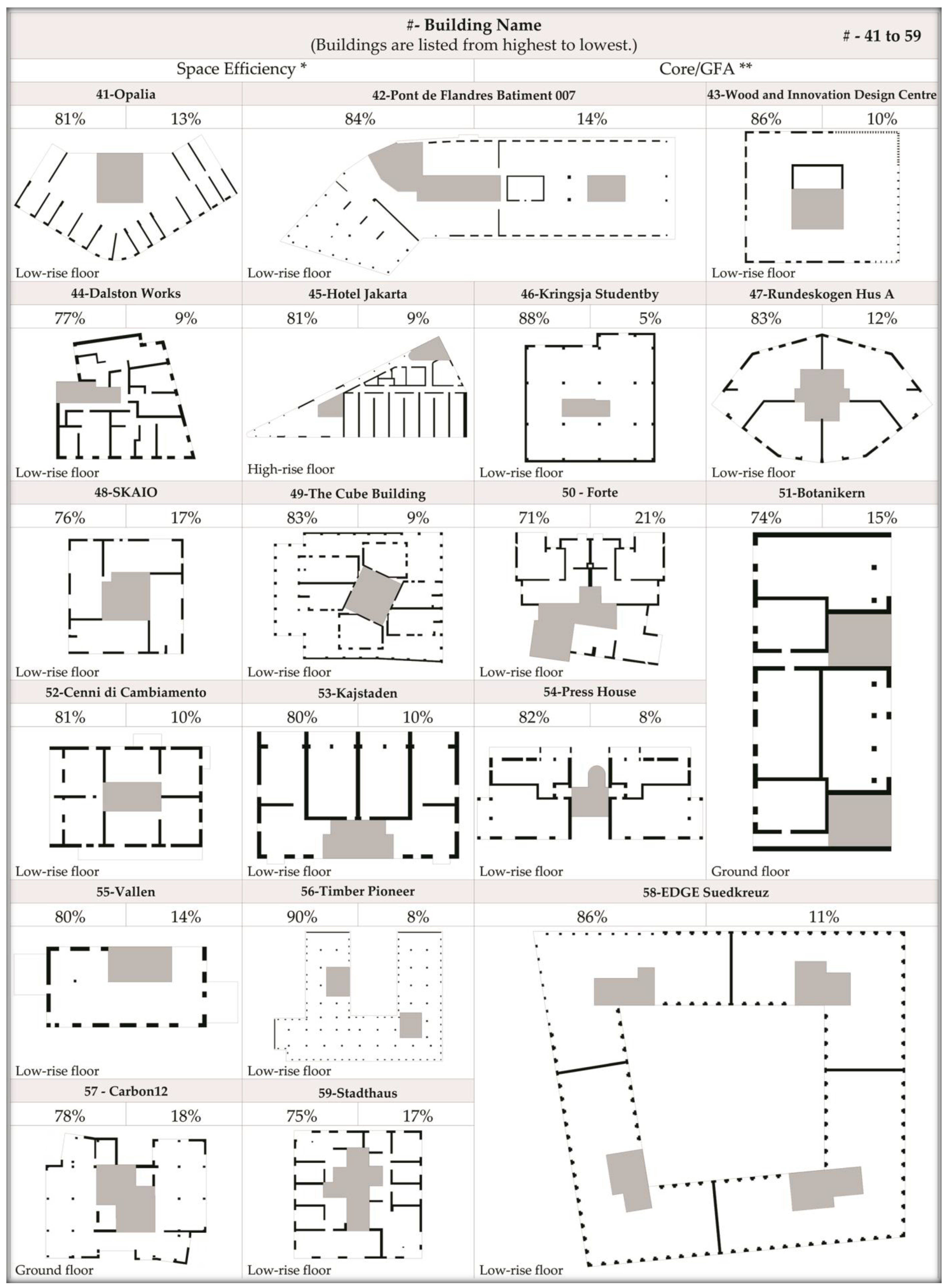
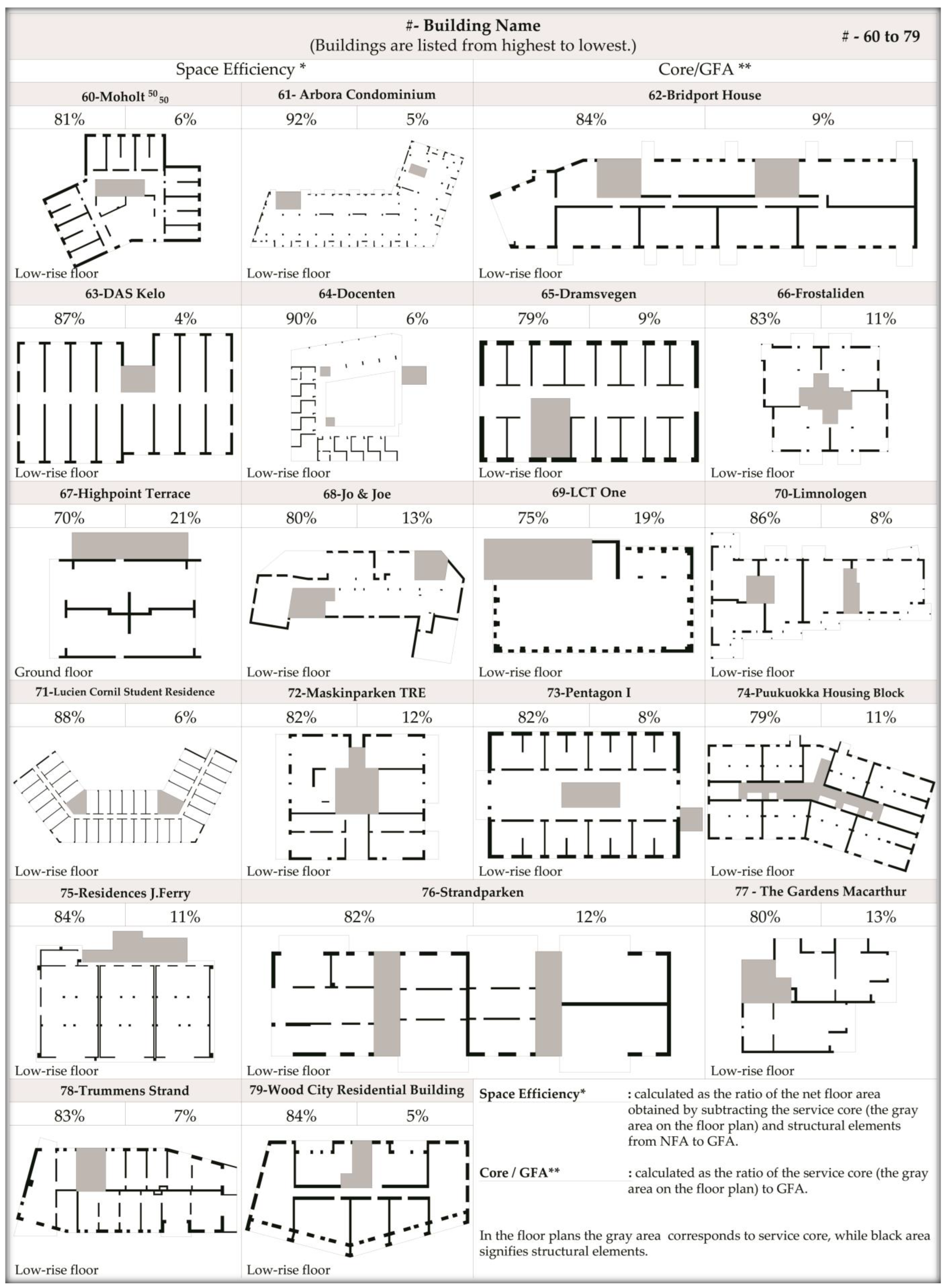
References
- Tupėnaitė, L.; Žilėnaitė, V.; Kanapeckienė, L.; Sajjadian, S.M.; Gečys, T.; Sakalauskienė, L.; Naimavičienė, J. Multiple criteria assessment of high-rise timber buildings. Eng. Struct. Technol. 2019, 11, 87–94. [Google Scholar] [CrossRef]
- Lafortezza, R.; Sanesi, G. Nature-based solutions: Settling the issue of sustainable urbanization. Environ. Res. 2019, 172, 394–398. [Google Scholar] [CrossRef]
- Bibri, S.E.; Krogstie, J. Environmentally data-driven smart sustainable cities: Applied innovative solutions for energy efficiency, pollution reduction, and urban metabolism. Energy Inform. 2020, 3, 29. [Google Scholar] [CrossRef]
- Mazutis, D.; Sweet, L. The business of accelerating sustainable urban development: A systematic review and synthesis. J. Clean. Prod. 2022, 357, 131871. [Google Scholar] [CrossRef]
- Tupenaite, L.; Zilenaite, V.; Kanapeckiene, L.; Gecys, T.; Geipele, I. Sustainability assessment of modern high-rise timber buildings. Sustainability 2021, 13, 8719. [Google Scholar] [CrossRef]
- Goubran, S.; Masson, T.; Walker, T. Diagnosing the local suitability of high-rise timber construction. Build. Res. Inf. 2020, 48, 101–123. [Google Scholar] [CrossRef]
- Cover, J. Mass timber: The new sustainable choice for tall buildings. Int. J. High-Rise Build. 2020, 9, 87–93. [Google Scholar]
- Žegarac Leskovar, V.; Premrov, M. A review of architectural and structural design typologies of multi-storey timber buildings in Europe. Forests 2021, 12, 757. [Google Scholar] [CrossRef]
- Kuys, B.; Mridha, M. Aesthetic Preference of Timber Joints in Architectural Products. Sustainability 2023, 16, 154. [Google Scholar] [CrossRef]
- Tenório, M.; Ferreira, R.; Belafonte, V.; Sousa, F.; Meireis, C.; Fontes, M.; Vale, I.; Gomes, A.; Alves, R.; Silva, S.M.; et al. Contemporary strategies for the structural design of multi-story modular timber buildings: A comprehensive review. Appl. Sci. 2024, 14, 3194. [Google Scholar] [CrossRef]
- Correa, D.; Krieg, O.D.; Meyboom, A. Beyond form definition: Material informed digital fabrication in timber construction. In Digital Wood Design: Innovative Techniques of Representation in Architectural Design; Springer: Berlin/Heidelberg, Germany, 2019; pp. 61–92. [Google Scholar]
- Sterley, M.; Serrano, E.; Källander, B. Building and construction: Timber engineering and wood-based products. In Adhesive Bonding; Woodhead Publishing: Sawston, UK, 2021; pp. 571–603. [Google Scholar]
- Sandberg, D.; Gorbacheva, G.; Lichtenegger, H.; Niemz, P.; Teischinger, A. Advanced Engineered Wood-Material Concepts. In Springer Handbook of Wood Science and Technology; Springer International Publishing: Cham, Switzerland, 2023; pp. 1835–1888. [Google Scholar]
- Fasasi, M.O. Assessing the Impact of Engineered Wood Products on Sustainable Construction: A Comparative Study with Conventional Concrete Building Methods. Open J. Eng. Sci. 2024, 5, 14–34. [Google Scholar] [CrossRef]
- Blanchet, P.; Perez, C.; Cabral, M.R. Wood Building Construction: Trends and Opportunities in Structural and Envelope Systems. Curr. For. Rep. 2024, 10, 21–38. [Google Scholar] [CrossRef]
- Aleksandr, C.; Tatiana, B.; Viktor, T.; Anton, K. On the possibility of using timber structures in the construction of high-rise buildings in seismic areas. Archit. Eng. 2023, 8, 60–70. [Google Scholar]
- Ciabattoni, M.; Petrini, F.; Pampanin, S. Multi-hazard design of low-damage high-rise steel–timber buildings subjected to wind and earthquake loading. Eng. Struct. 2024, 303, 117522. [Google Scholar] [CrossRef]
- Ussher, E.; Aloisio, A.; Rathy, S. Effect of lateral resisting systems on the wind-induced serviceability response of tall timber buildings. Case Stud. Constr. Mater. 2023, 19, e02540. [Google Scholar] [CrossRef]
- Adelzadeh, A.; Karimian-Aliabadi, H.; Åhlund, K.; Robeller, C. ReciprocalShell A hybrid timber system for robotically-fabricated lightweight shell structures. In Proceedings of the 41st Conference on Education and Research in Computer Aided Architectural Design in Europe (eCAADe 2023), Graz, Austria, 18–23 September 2023; pp. 20–23. [Google Scholar]
- Pastori, S.; Mazzucchelli, E.S.; Wallhagen, M. Hybrid timber-based structures: A state of the art review. Constr. Build. Mater. 2022, 359, 129505. [Google Scholar] [CrossRef]
- Casagrande, D.; Sinito, E.; Izzi, M.; Pasetto, G.; Polastri, A. Structural performance of a hybrid timber wall system for emergency housing facilities. J. Build. Eng. 2021, 33, 101566. [Google Scholar] [CrossRef]
- Scouse, A.; Kelley, S.S.; Liang, S.; Bergman, R. Regional and net economic impacts of high-rise mass timber construction in Oregon. Sustain. Cities Soc. 2020, 61, 102154. [Google Scholar] [CrossRef]
- Piette, M.A.; Diamond, R.; Selkowitz, S.; de la Rue du Can, S.; Hong, T.; Sun, K.; Alstone, P. Global Opportunities and Challenges in Energy and Environmental Issues in the Buildings Sector. In Energy Efficiency: Innovations: Driving Prosperity, Slashing Emissions; World Scientific: Singapore, 2021; pp. 31–132. [Google Scholar]
- Orta Rial, M.B.; Martínez Gayá, J.E.; Cervera Bravo, J.; Aira Zunzunegui, J.R. Timber high rise, state of the art. Inf. Constr. 2020, 72, 346. [Google Scholar]
- Gu, H.; Liang, S.; Bergman, R. Comparison of building construction and life-cycle cost for a high-rise mass timber building with its concrete alternative. For. Prod. J. 2020, 70, 482–492. [Google Scholar] [CrossRef]
- Švajlenka, J.; Kozlovská, M. Evaluation of the efficiency and sustainability of timber-based construction. J. Clean. Prod. 2020, 259, 120835. [Google Scholar] [CrossRef]
- Ahmed, S.; Arocho, I. Analysis of cost comparison and effects of change orders during construction: Study of a mass timber and a concrete building project. J. Build. Eng. 2021, 33, 101856. [Google Scholar] [CrossRef]
- Wagner, H.J.; Alvarez, M.; Groenewolt, A.; Menges, A. Towards digital automation flexibility in large-scale timber construction: Integrative robotic prefabrication and co-design of the BUGA Wood Pavilion. Constr. Robot. 2020, 4, 187–204. [Google Scholar] [CrossRef]
- Cheng, Z.; Tang, S.; Liu, H.; Lei, Z. Digital technologies in offsite and prefabricated construction: Theories and applications. Buildings 2023, 13, 163. [Google Scholar] [CrossRef]
- Monizza, G.P.; Di Blasio, I.; Matt, D.T. Exploring applications of Computational Design techniques and Design for Manufacturability for costs reduction of prefabricated timber-based façades: The ‘LegnAttivo’ design prototype. Dev. Built Environ. 2024, 19, 100489. [Google Scholar] [CrossRef]
- Zhang, Y.; Su, Z.; Ni, W.; Zhang, X.; Wang, L. Experimental study and theoretical analysis of fire resistance properties of prestressed glued laminated timber beams. Constr. Build. Mater. 2024, 424, 135967. [Google Scholar] [CrossRef]
- Deepa, M.S.; Shukla, S.R.; Kelkar, B.U. Overview of applications of near infrared (NIR) spectroscopy in wood science: Recent advances and future prospects. J. Indian Acad. Wood Sci. 2024, 21, 34–57. [Google Scholar] [CrossRef]
- Khramov, I.; Aun, D. Selection of controlled parameters of the technological process of obtaining CLT panels with increased sound insulation. In ITM Web of Conferences; EDP Sciences: Les Ulis, France, 2024; Volume 59, p. 01001. [Google Scholar]
- Michalak, H.; Michalak, K. Selected Aspects of Sustainable Construction—Contemporary Opportunities for the Use of Timber in High and High-Rise Buildings. Energies 2024, 17, 1961. [Google Scholar] [CrossRef]
- Ascione, F.; Esposito, F.; Iovane, G.; Faiella, D.; Faggiano, B.; Mele, E. Sustainable and efficient structural systems for tall buildings: Exploring timber and steel–timber hybrids through a case study. Buildings 2024, 14, 524. [Google Scholar] [CrossRef]
- Ahmed, D.; Dernayka, S.; R Chowdhury, S.; Asiz, A.; Ayadat, T. Sustainable timber building and its carbon emission analysis in the LINE-NEOM. Mech. Adv. Mater. Struct. 2023, 1–9. [Google Scholar] [CrossRef]
- Nguyen, L.P.; van den Berg, P.E.; Kemperman, A.D.; Mohammadi, M. Social impacts of living in high-rise apartment buildings: The effects of buildings and neighborhoods. J. Urban Aff. 2024, 1–22. [Google Scholar] [CrossRef]
- Whyte, S.; Kaburagi, R.; Gan, V.; Candido, C.; Avazpour, B.; Fatourehchi, D.; Chan, H.F.; Dong, Y.; Dulleck, U.; Finlay, S.; et al. Exploring the Benefits of Mass Timber Construction in the Workplace: A Novel Primer for Research. Buildings 2024, 14, 2072. [Google Scholar] [CrossRef]
- Altomonte, S.; Allen, J.; Bluyssen, P.M.; Brager, G.; Heschong, L.; Loder, A.; Schiavon, S.; Veitch, J.A.; Wang, L.; Wargocki, P. Ten questions concerning well-being in the built environment. Build. Environ. 2020, 180, 106949. [Google Scholar] [CrossRef]
- Pinaykin, I.P.; Zhadanov, V.I.; Ukrainchenko, D.A. Wooden low-rise construction. New constructive and technological solutions. IOP Conf. Ser. Earth Environ. Sci. 2021, 751, 012092. [Google Scholar] [CrossRef]
- Ilgın, H.E.; Karjalainen, M.; Pelsmakers, S. Finnish architects’ attitudes towards multi-storey timber-residential buildings. Int. J. Build. Pathol. Adapt. 2024, 42, 352–368. [Google Scholar] [CrossRef]
- Marfella, G.; Winson-Geideman, K. Timber and multi-storey buildings: Industry perceptions of adoption in Australia. Buildings 2021, 11, 653. [Google Scholar] [CrossRef]
- Gilbert, B.; Skitmore, M.; Ali, Y.; Gray, J. Key considerations of cross-laminated timber (CLT) for high-rise construction in Australia: A review. NICMAR J. Constr. Manag. 2020, 35, 70–81. [Google Scholar]
- Ilgın, H.E.; Karjalainen, M. Tallest Timber Buildings: Main Architectural and Structural Design Considerations, Wood Industry—Past, Present and Future Outlook; IntechOpen: London, UK, 2022. [Google Scholar]
- Chen, F.; Li, M.; Li, Z. Self-centering mass timber structures: A review on recent research progress. Eng. Struct. 2024, 303, 117474. [Google Scholar] [CrossRef]
- Ilgın, H.E.; Karjalainen, M.; Koponen, O. Dovetailed Massive Wood Board Elements for Multi-Story Buildings. In Proceedings of the LIVENARCH VII Livable Environments & Architecture 7th International Congress OTHER ARCHITECT/URE(S), Trabzon, Turkey, 28–30 September 2021; Volume 1, pp. 47–60. [Google Scholar]
- Pan, Y.; An, R.; You, W.; Fan, Y. A mechanical model used for the multifactor analysis of through-tenon joints in traditional Chinese timber structures. Int. J. Archit. Herit. 2024, 18, 551–576. [Google Scholar] [CrossRef]
- Ilgın, H.E.; Aslantamer, Ö.N. Analysis of Space Efficiency in High-Rise Timber Residential Towers. Appl. Sci. 2024, 14, 4337. [Google Scholar] [CrossRef]
- Aslantamer, Ö.N.; Ilgın, H.E. Space efficiency in timber office buildings. J. Build. Eng. 2024, 91, 109618. [Google Scholar] [CrossRef]
- Tuure, A.; Ilgın, H.E. Space Efficiency in Finnish Mid-Rise Timber Apartment Buildings. Buildings 2023, 13, 2094. [Google Scholar] [CrossRef]
- Ilgın, H.E. A study on space efficiency in contemporary supertall mixed-use buildings. J. Build. Eng. 2023, 69, 106223. [Google Scholar] [CrossRef]
- Ilgın, H.E. Space Efficiency in Contemporary Supertall Residential Buildings. Architecture 2021, 1, 25–37. [Google Scholar] [CrossRef]
- Ilgın, H.E. Space Efficiency in Contemporary Supertall Office Buildings. J. Archit. Eng. 2021, 27, 04021024. [Google Scholar] [CrossRef]
- Ilgın, H.E. An analysis of space efficiency in Asian supertall towers. Int. J. Build. Pathol. Adapt. 2023, 41, 237–253. [Google Scholar] [CrossRef]
- Ilgın, H.E. Examination of spatial efficiency in super-tall towers within the Middle Eastern context. Open House Int. ahead-of-print. 2024. [Google Scholar] [CrossRef]
- Aslantamer, Ö.N.; Ilgın, H.E. Space Efficiency in Tall Hotel Towers. Buildings 2024, 14, 2051. [Google Scholar] [CrossRef]
- Aslantamer, Ö.N.; Ilgın, H.E. Evaluating Space Efficiency of Tall Buildings in Turkey. Buildings 2024, 14, 2138. [Google Scholar] [CrossRef]
- Ilgın, H.E.; Aslantamer, Ö.N. Investigating Space Utilization in Skyscrapers Designed with Prismatic Form. Buildings 2024, 14, 1295. [Google Scholar] [CrossRef]
- Ilgın, H.E. Space Efficiency in Tapered Super-Tall Towers. Buildings 2023, 13, 2819. [Google Scholar] [CrossRef]
- Okbaz, F.T.; Sev, A. A model for determining the space efficiency in non-orthogonal high rise office buildings. J. Fac. Eng. Archit. Gazi Univ. 2023, 38, 113–125. [Google Scholar]
- Ibrahimy, R.; Mohmmand, M.A.; Elham, F.A. An Evaluation of Space Use Efficiency in Residential Houses, Kabul City. J. Res. Appl. Sci. Biotechnol. 2023, 2, 1–6. [Google Scholar] [CrossRef]
- Hamid, G.M.; Elsawi, M.; Yusra, O. The Impacts of Spatial Parameters on Space Efficiency in Hybrid Villa-Apartments in Greater Khartoum, Sudan. J. Archit. Plan. 2022, 34, 425–440. [Google Scholar]
- Suga, R. Space Efficiency in Hotel Development. Master’s Thesis, MODUL University Vienna, Vienna, Austria, 2021. [Google Scholar]
- Goessler, T.; Kaluarachchi, Y. Smart Adaptive Homes and Their Potential to Improve Space Efficiency and Personalisation. Buildings 2023, 13, 1132. [Google Scholar] [CrossRef]
- Arslan Kılınç, G. Improving a Model for Determining Space Efficiency of Tall Office Buildings. Ph.D. Thesis, Department of Architecture, Mimar Sinan Fine Art University, Istanbul, Turkey, 2019. (In Turkish). [Google Scholar]
- Sev, A.; Özgen, A. Space efficiency in high-rise office buildings. METU J. Fac. Archit. 2009, 26, 69–89. [Google Scholar] [CrossRef]
- Kim, H.; Elnimeiri, M. Space efficiency in multi-use tall building. In Proceedings of the Tall Buildings in Historical Cities-Culture and Technology for Sustainable Cities, Seoul, Republic of Korea, 10–13 October 2004. [Google Scholar]
- Höjer, M.; Mjörnell, K. Measures and steps for more efficient use of buildings. Sustainability 2018, 10, 1949. [Google Scholar] [CrossRef]
- Nam, H.J.; Shim, J.H. An analysis of the change in space efficiency based on various tall building corner shapes and lease spans. J. Archit. Inst. Korea Plan. Des. 2016, 32, 13–20. [Google Scholar]
- Zhang, L.; Zhang, L.; Wang, Y. Shape optimization of free-form buildings based on solar radiation gain and space efficiency using a multi-objective genetic algorithm in the severe cold zones of China. Sol. Energy 2016, 132, 38–50. [Google Scholar] [CrossRef]
- Saari, A.; Tissari, T.; Valkama, E.; Seppänen, O. The effect of a Redesigned Floor Plan, Occupant Density and the Quality of Indoor Climate on the Cost of Space, Productivity and Sick Leave in an Office Building—A Case Study. Build. Environ. 2006, 41, 1961–1972. [Google Scholar] [CrossRef]
- Von Both, P. A stakeholder-and function-based planning method for space-efficient buildings. IOP Conf. Ser. Earth Environ. Sci. 2019, 323, 012040. [Google Scholar] [CrossRef]
- Wang, P.; Yang, Y.; Ji, C.; Huang, L. Influence of built environment on building energy consumption: A case study in Nanjing, China. Environ. Dev. Sustain. 2023, 26, 5199–5222. [Google Scholar] [CrossRef]
- Ilgın, H.E. Use of Aerodynamically Favorable Tapered Form in Contemporary Supertall Buildings. J. Des. Resil. Archit. Plan. 2022, 3, 183–196. [Google Scholar] [CrossRef]
- Miao, J.T.; Aritenang, A.F.; Gissma, N. Smart city in the creativity-built environment nexus: A case study of Bandung. In Routledge Companion to Creativity and the Built Environment; Routledge: London, UK, 2024; pp. 435–447. [Google Scholar]
- Carapellucci, F.; Conti, V.; Lelli, M.; Liberto, C.; Orchi, S.; Valenti, G.; Valentini, M.P. Tools and Methodologies for the Analysis of Home-to-Work Shuttle Service Impacts: The ENEA “Casaccia” Case Study. Futur. Transp. 2023, 3, 901–917. [Google Scholar] [CrossRef]
- CTBUH Council on Tall Buildings Urban Habitat Illinois Institute of Technology, S.R. Crown Hall, 3360 South State Street, Chicago, Illinois, USA. Available online: www.ctbuh.org (accessed on 23 August 2024).
- Kohn, A.E.; Katz, J. Building Type Basics for Office Buildings; Kliment, S.A., Ed.; Wiley: New York, NY, USA, 2002. [Google Scholar]
- Trabucco, D. An analysis of the relationship between service cores and the embodied/running energy of tall buildings. Struct. Des. Tall Spec. Build. 2008, 17, 941–952. [Google Scholar] [CrossRef]
- Trabucco, D. Historical Evolution of the Service Core. CTBUH J. 2010, 42–47. Available online: https://global.ctbuh.org/resources/papers/download/394-historical-evolution-of-the-service-core.pdf (accessed on 23 August 2024).
- Aldred, J. Burj Khalifa—A new high for high-performance concrete. Proc. Inst. Civ. Eng.-Civ. Eng. 2010, 163, 66–73. [Google Scholar] [CrossRef]
- Marcus, S. The new supers: Super-slender towers of new york. In Proceedings of the CTBUH 2015 International Conference «Global Interchanges: Resurgence of the Skyscraper City», New York, NY, USA, 26–30 October 2015; pp. 60–65. [Google Scholar]
- Hammoud, M.; Baker, W.; Scheeren, O.; Parakh, J.; Hean, C.K.; Lochhead, H.; Murray, P.; Azad, M.K.; Pasquarelli, G.; Wood, A.; et al. CTBUH 2018 Conference Special. CTBUH J. 2018, 4, 44–51. [Google Scholar]
- Vollers, K. Morphological Scheme of Second-Generation Non-Orthogonal High-Rises. In Proceedings of the 8th World Congress of the Council on Tall Buildings and Urban Habitat: Tall & Green: Typology for a Sustainable Urban Future, Post Congress Review, Dubai, United Arab Emirates, 3–5 March 2008; pp. 504–512. [Google Scholar]
- Al-Kodmany, K.; Ali, M.M. An Overview of Structural and Aesthetic Developments in Tall Buildings Using Exterior Bracing and Diagrid Systems. Int. J. High-Rise Build. 2016, 5, 271–291. [Google Scholar] [CrossRef]
- Schueller, W. High-Rise Building Structures; Wiley: New York, NY, USA, 1977. [Google Scholar]
- Smith, B.S.; Coull, A. Tall Building Structures: Analysis and Design; Wiley: New York, NY, USA, 1991. [Google Scholar]
- Taranath, B. Steel, Concrete & Composite Design of Tall Buildings; McGraw-Hill Book: New York, NY, USA, 1998. [Google Scholar]
- Ali, M.M.; Moon, K.S. Structural Developments in Tall Buildings: Current Trends and Future Prospects. Arch. Sci. Rev. 2007, 50, 205–223. [Google Scholar] [CrossRef]
- Baker, W.F.; Brown, C.D.; Young, B.S.; Zachrison, E. Infinity Tower, Dubai, UAE. Struct. Congr. 2010, 2010, 3078–3087. [Google Scholar]
- Ali, M.M.; Moon, K.S. Advances in Structural Systems for Tall Buildings: Emerging Developments for Contemporary Urban Giants. Buildings 2018, 8, 104. [Google Scholar] [CrossRef]
- Moon, K.S. Developments of Structural Systems Toward Mile-High Towers. Int. J. High-Rise Build. 2018, 7, 197–214. [Google Scholar]
- Fu, F. Design and Analysis of Tall and Complex Structures; Butterworth-Heinemann: Oxford, UK; Cambridge, UK; Elsevier: Amsterdam, The Netherlands, 2018. [Google Scholar]
- Ilgın, H.E. Core Design and Space Efficiency in Contemporary Supertall Office Buildings. In Sustainable High-Rise Buildings: Design, Technology, and Innovation; Al-Kodmany, K., Du, P., Ali, M.M., Eds.; The Institution of Engineering and Technology: London, UK, 2022. [Google Scholar]
- Vacek, Z.; Vacek, S.; Cukor, J. European forests under global climate change: Review of tree growth processes, crises and management strategies. J. Environ. Manag. 2023, 332, 117353. [Google Scholar] [CrossRef]
- Matiiuk, Y.; Krikštolaitis, R.; Liobikienė, G. The COVID-19 pandemic in context of climate change perception and resource-saving behavior in the European Union countries. J. Clean. Prod. 2023, 395, 136433. [Google Scholar] [CrossRef]
- Wang, W. Research on Seismic Design of High-Rise Buildings Based on Framed-Shear Structural System. Front. Res. Archit. Eng. 2020, 3, 87–90. [Google Scholar] [CrossRef]
- Abdulhadi, M.; Xun’an, Z.; Atroshchenko, E.; Rungamornrat, J. Vibration control of inerter-enhanced mega sub-controlled structure system (MSCSS) and the reliability analysis of the structure under seismic action. Eng. Struct. 2024, 304, 117508. [Google Scholar] [CrossRef]
- Angelucci, G.; Mollaioli, F.; Molle, M.; Paris, S. Performance assessment of Timber High-rise Buildings: Structural and Technological Considerations. Open Constr. Build. Technol. J. 2022, 16, e187483682206270. [Google Scholar] [CrossRef]
- Binck, C.; Cao, A.S.; Frangi, A. Lateral stiffening systems for tall timber buildings–tube-in-tube systems. Wood Mater. Sci. Eng. 2022, 17, 309–316. [Google Scholar] [CrossRef]
- Stulen, J. The use of mass timber—An update. N. Z. J. For. 2019, 64, 26–31. [Google Scholar]
- Dias, A.M.P.G.; Skinner, J.; Crews, K.; Tannert, T. Timber-concrete-composites increasing the use of timber in construction. Eur. J. Wood Wood Prod. 2016, 74, 443–451. [Google Scholar] [CrossRef]
- Hanták, J.; Končeková, D. Positive effects of wood in Vorarlberg’s (Austria) timber kindergartens. Archit. Pap. Fac. Archit. Des. STU 2023, 28, 36–49. [Google Scholar] [CrossRef]
- Dharanidharan, K.; Selvanayaki, S.; Divya, K.; Ravikumar, R.; Raj, S.V. Exploring Household Wood Preferences among Consumers in Coimbatore. Asian J. Agric. Ext. Econ. Sociol. 2023, 41, 196–203. [Google Scholar] [CrossRef]
- Karjalainen, M.; Ilgın, H.E.; Somelar, D. Wooden Extra Stories in Concrete Block of Flats in Finland as an Ecologically Sensitive Engineering Solution; IntechOpen: London, UK, 2021. [Google Scholar]
- Yeang, K. Service Cores: Detail in Building; Wiley-Academy: London, UK, 2000. [Google Scholar]
- Abed, J.; Rayburg, S.; Rodwell, J.; Neave, M. A Review of the Performance and Benefits of Mass Timber as an Alternative to Concrete and Steel for Improving the Sustainability of Structures. Sustainability 2022, 14, 5570. [Google Scholar] [CrossRef]
- Caniato, M.; Marzi, A.; da Silva, S.M.; Gasparella, A. A review of the thermal and acoustic properties of materials for timber building construction. J. Build. Eng. 2021, 43, 103066. [Google Scholar] [CrossRef]
- Ramage, M.H.; Burridge, H.; Busse-Wicher, M.; Fereday, G.; Reynolds, T.; Shah, D.U.; Wu, G.; Yu, L.; Fleming, P.; Densley-Tinglet, D.; et al. The wood from the trees: The use of timber in construction. Renew. Sustain. Energy Rev. 2017, 68, 333–359. [Google Scholar] [CrossRef]
- Wenzel, A.; Vera, S.; Guindos, P. Energy and structural optimization of mid-rise light-frame timber buildings for different climates and seismic zones in Chile. Eur. J. Wood Wood Prod. 2024, 82, 967–982. [Google Scholar] [CrossRef]
- Cui, W.; Gattas, J.M.; Heitzmann, M.T. Manufacture and structural performance of modular hybrid FRP–timber thin-walled beams. Constr. Build. Mater. 2024, 435, 136705. [Google Scholar] [CrossRef]
- Haase, P.; Boretzki, J.; Aurand, S.; Sandhaas, C.; Ummenhofer, T.; Albiez, M. Influence of the joining technique on the structural behaviour of hybrid timber-steel cross-sections. J. Adhes. 2024, 1–28. [Google Scholar] [CrossRef]
- Al-Najjar, A.; Dodoo, A. Modular multi-storey construction with cross-laminated timber: Life cycle environmental implications. Wood Mater. Sci. Eng. 2023, 18, 525–539. [Google Scholar] [CrossRef]
- Gutiérrez, N.; Negrão, J.; Dias, A.; Guindos, P. Bibliometric review of prefabricated and modular timber construction from 1990 to 2023: Evolution, trends, and current challenges. Sustainability 2024, 16, 2134. [Google Scholar] [CrossRef]
- Bhandari, S.; Riggio, M.; Jahedi, S.; Fischer, E.C.; Muszynski, L.; Luo, Z. A review of modular cross laminated timber construction: Implications for temporary housing in seismic areas. J. Build. Eng. 2023, 63, 105485. [Google Scholar] [CrossRef]
- Paul, D.; Gaff, M.; Tesařová, D.; Hui, D.; Li, H. Recent advancements in nanotechnology application on wood and bamboo materials: A review. Nanotechnol. Rev. 2023, 12, 20220528. [Google Scholar] [CrossRef]
- Ahmadizadeh, M.; Heidari, M.; Thangavel, S.; Khashehchi, M.; Rahmanivahid, P.; Singh, V.P.; Kumar, A. Development of new materials for sustainable buildings. In Sustainable Technologies for Energy Efficient Buildings; CRC Press: Boca Raton, FL, USA, 2024; pp. 30–48. [Google Scholar]
- Kuzmanovska, I.; Gasparri, E.; Monne, D.T.; Aitchison, M. Tall timber buildings: Emerging trends and typologies. In Proceedings of the 2018 World Conference on Timber Engineering (WCTE 2018), Seoul, Republic of Korea, 20–23 August 2018. [Google Scholar]
- Zahiri, N. Timber High-Rises in Nordic Countries: Current Trends. CTBUH J. 2023, 44–50. Available online: https://www.proquest.com/openview/18bd24c28e7b2ef07815ea4e8423a3b6/1?pq-origsite=gscholar&cbl=6578554 (accessed on 23 August 2024).
- Borucka, J.; Zybała, T.; Norvaisiene, R. Building new competencies of architects and civil engineers through an educational offer in timber construction: A case study of Polish and Lithuanian students. Glob. J. Eng. Educ. 2024, 26, 129–135. [Google Scholar]
- Feizbahr, M.; Pourzanjani, P. Nanotechnology in Construction: Innovations, Applications, and Impacts. J. Civ. Eng. Res. 2024, 6, 35–41. [Google Scholar] [CrossRef]
- Souaid, C.; ten Caat, P.N.; Meijer, A.; Visscher, H. Downsizing and the use of timber as embodied carbon reduction strategies for new-build housing: A partial life cycle assessment. Build. Environ. 2024, 253, 111285. [Google Scholar] [CrossRef]
- Ouellet-Plamondon, C.M.; Balouktsi, M.; Delem, L.; Foliente, G.; Francart, N.; Garcia-Martinez, A.; Hoxha, E.; Lützkendorf, T.; Nygaard Rasmussen, F.; Peuportier, B.; et al. Comparison of 16 national methods in the life cycle assessment of carbon storage in wood products in a reference building. IOP Conf. Ser. Earth Environ. Sci. 2024, 1363, 012059. [Google Scholar] [CrossRef]
- Balasbaneh, A.T.; Sher, W. Economic and environmental life cycle assessment of alternative mass timber walls to evaluate circular economy in building: MCDM method. Environ. Dev. Sustain. 2024, 26, 239–268. [Google Scholar] [CrossRef]
- Zang, X.; Liu, W.; Wu, D.; Pan, X.; Zhang, W.; Bian, H.; Shen, R. Contemporary fire safety engineering in timber structures: Challenges and solutions. Fire 2023, 7, 2. [Google Scholar] [CrossRef]
- Alhassan, M.; Alkhawaldeh, A.; Betoush, N.; Sawalha, A.; Amaireh, L.; Onaizi, A. Harmonizing smart technologies with building resilience and sustainable built environment systems. Results Eng. 2024, 22, 102158. [Google Scholar] [CrossRef]
- Chapain, S.; Aly, A.M. Vibration attenuation in a high-rise hybrid-timber building: A comparative study. Appl. Sci. 2023, 13, 2230. [Google Scholar] [CrossRef]
- van Veelen, B.; Knuth, S. An urban ‘age of timber’? Tensions and contradictions in the low-carbon imaginary of the bioeconomic city. Environ. Plan. E Nat. Space 2024, 7, 904–927. [Google Scholar] [CrossRef]
- Ahmad, F.; Allan, K.; Phillips, A.R. Multicriteria decision analysis of steel and mass timber prototype buildings in the Pacific Northwest. J. Archit. Eng. 2023, 29, 04023001. [Google Scholar] [CrossRef]
- Viljanen, A.; Lähtinen, K.; Kanninen, V.; Toppinen, A. A tale of five cities: The role of municipalities in the market diffusion of wooden residential multistory construction and retrofits. For. Policy Econ. 2023, 153, 102991. [Google Scholar] [CrossRef]
Disclaimer/Publisher’s Note: The statements, opinions and data contained in all publications are solely those of the individual author(s) and contributor(s) and not of MDPI and/or the editor(s). MDPI and/or the editor(s) disclaim responsibility for any injury to people or property resulting from any ideas, methods, instructions or products referred to in the content. |
© 2024 by the authors. Licensee MDPI, Basel, Switzerland. This article is an open access article distributed under the terms and conditions of the Creative Commons Attribution (CC BY) license (https://creativecommons.org/licenses/by/4.0/).